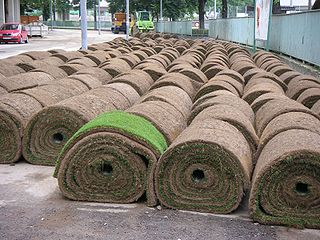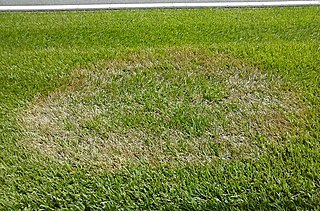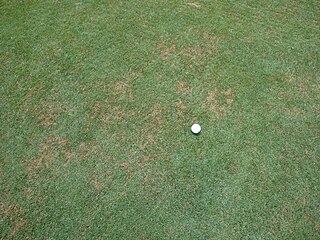Related Research Articles

Fusarium patch is a disease in turf grass settings also called pink snow mold or Microdochium patch. In many cool season grass species in North America, it is caused by the fungus Microdochium nivale. The white-pink mycelium on infected leaf blades is a distinguishing characteristic of the Microdochium nivale pathogen. Fusarium patch is considered economically important in the turf grass industry because of its tendency to cause significant injury to golf greens, thereby decreasing putting surface quality. Dissimilar from other snow molds, such as gray snow mold, Microdochium nivale does not need snow cover to cause widespread infection.

Sod is the upper layer of turf that is harvested for transplanting. Turf consists of a variable thickness of a soil medium that supports a community of turfgrasses.
Pythium volutum is a plant pathogen infecting wheat, barley, and turfgrass. It is known to be sensitive to some of the compounds typically present in selective media commonly used for isolating Pythium spp., so isolation may require alternative methods.

Typhula incarnata is a fungal plant pathogen in the family Typhulaceae.
Typhula ishikariensis is, along with Typhula incarnata, the causal agent of grey snow mould, an obligately parasitic plant pathogen that can destroy turfgrass when covered for a long period with snow. It is a particular problem on golf courses established in unsuitable areas. More importantly, it can also damage crops of winter wheat. The species was described as new to science in 1930 by Japanese mycologist Sanshi Imai. The varieties canadensis and ishikariensis were described in 1978. There is a wide variety within the species and not all authorities agree as to subspecies, or even whether it should be monophyletic.
Colletotrichum cereale is a plant disease (fungus) that has been found to cause crown rot anthracnose of turf grass most commonly occurring on golf courses. Anthracnose can occur as both a foliar blight and basal rot. This disease attacks the crowns of plants, which is different than other anthracnose diseases. Anthracnose of turfgrass can be a foliar disease or in this case a basal rot of the lower portion of the plant. It attacks different species of turfgrass throughout the world most commonly annual bluegrass and creeping bentgrass.
Magnaporthe poae is an ascomycete fungus which causes the turfgrass disease commonly known as summer patch, or Poa patch. The disease occurs mostly on Kentucky bluegrass (Poa pratensis), Fescues (Festuca sp.), and on Annual bluegrass (Poa annua). Bentgrass may also become infected but shows very few symptoms and quickly recovers. Summer Patch will usually become noticeable between June and September, although small signs can appear at any time but are not noticeable because the turfgrass can recover quickly.

Brown patch is a common turfgrass fungal disease that is caused by species in the genus Rhizoctonia, usually Rhizoctonia solani. Brown patch can be found in all of the cool season turfgrasses found in the United States. Brown patch is most devastating to: Bentgrass, ryegrass, Annual bluegrass, and Tall fescue. Brown patch is also found in Kentucky bluegrass and Fine fescue but this is rare or does minimal damage. Brown patch is known as a foliar disease, so it does not have any effect on the crown or roots of the turf plant.
Pythiumdisease, also known as "Pythiumblight," "cottony blight," or "grease spot," is a highly destructive turfgrass disease caused by several different Pythium species. All naturally cultivated cool-season turfgrasses are susceptible to Pythium and if conditions are favorable to Pythium it can destroy a whole turfgrass stand in a few days or less. Pythium favors hot and very humid weather and will usually develop in low areas or swales in the turfgrass.
Red thread disease is a fungal infection found on lawns and other turfed areas. It is caused by the corticioid fungus Laetisaria fuciformis and has two separate stages. The stage that gives the infection its name is characterised by very thin, red, needle-like strands extending from the grass blade. These are stromata, which can remain viable in soil for two years. After germinating, the stromata infect grass leaf blades through their stomata. The other stage is visible as small, pink, cotton wool-like mycelium, found where the blades meet. It is common when both warmth and humidity are high.

Typhula is a genus of clavarioid fungi in the order Agaricales. Species of Typhula are saprotrophic, mostly decomposing leaves, twigs, and herbaceous material. Basidiocarps are club-shaped or narrowly cylindrical and are simple, often arising from sclerotia. A few species are facultative plant pathogens, causing a number of commercially important crop and turfgrass diseases.
Dollar spot is a fungal disease of turfgrass caused by the four species in the genus Clarireedia, in the family Rutstroemiaceae. The pathogen blights leaf tissues but does not affect turf grass roots or crowns. There is evidence that a fungal mycotoxin produced by the pathogen may cause root damage, including necrosis of the apical meristem in creeping bentgrass. However, the importance of this toxin is unknown and its effects are not considered a direct symptom of dollar spot. The disease is a common concern on golf courses on intensely managed putting greens, fairways and bowling greens. It is also common on less rigorously maintained lawns and recreational fields. Disease symptoms commonly result in poor turf quality and appearance. The disease occurs from late spring through late fall, but is most active under conditions of high humidity and warm daytime temperatures 59–86 °F (15–30 °C) and cool nights in the spring, early summer and fall. The disease infects by producing a mycelium, which can be spread mechanically from one area to another.

Paspalum vaginatum is a species of grass known by many names, including seashore paspalum, biscuit grass, saltwater couch, silt grass, and swamp couch. It is native to the Americas, where it grows in tropical and subtropical regions. It is found throughout the other tropical areas of the world, where it is an introduced species and sometimes an invasive weed. It is also cultivated as a turfgrass in many places.
Snow mold is a type of fungus and a turf disease that damages or kills grass after snow melts, typically in late winter. Its damage is usually concentrated in circles three to twelve inches in diameter, although yards may have many of these circles, sometimes to the point at which it becomes hard to differentiate between different circles. Snow mold comes in two varieties: pink or gray. While it can affect all types of grasses, Kentucky bluegrass and fescue lawns are least affected by snow mold.

Turf melting out is caused by the fungal pathogen Dreschlera poae, in the family Pleosporaceae. It is a common problem on turfgrass and affects many different species. The disease infects all parts of the plant most commonly on golf course roughs, sports fields, and home lawns. There are two stages of the disease: the leaf blade infection and the crown and root infection Melting out occurs during the cool weather of April and May and is encouraged by high nitrogen fertility. The disease is spread by wind-blown or water splashed spores and survive in thatch.

Brown ring patch is a recently described Rhizoctonia-like disease of turf grass caused by the fungus Waitea circinata var. circinata. The disease primarily affects putting greens and causes yellow or brown rings up to 1 metre (3.3 ft) in diameter. Brown ring patch was first observed in Japan and has since spread to the United States and China (2011).
Bacterial wilt of turfgrass is the only known bacterial disease of turf. The causal agent is the Gram negative bacterium Xanthomonas translucens pv. graminis. The first case of bacterial wilt of turf was reported in a cultivar of creeping bentgrass known as Toronto or C-15, which is found throughout the midwestern United States. Until the causal agent was identified in 1984, the disease was referred to simply as C-15 decline. This disease is almost exclusively found on putting greens at golf courses where extensive mowing creates wounds in the grass which the pathogen uses in order to enter the host and cause disease.
Necrotic ring spot is a common disease of turf caused by soil borne fungi that mainly infects roots (4). It is an important disease as it destroys the appearance of turfgrasses on park, playing fields and golf courses. Necrotic Ring Spot is caused by a fungal pathogen that is an ascomycete that produces ascospores in an ascocarp (6). They survive over winter, or any unfavorable condition as sclerotia. Most infection occurs in spring and fall when the temperature is about 13 to 28 °C (5). The primary hosts of this disease are cool-season grasses such as Kentucky bluegrass and annual bluegrass (6). Once turf is infected with O. korrae, it kills turf roots and crowns. Symptoms of the disease are quite noticeable since they appear as large yellow ring-shaped patches of dead turf. Management of the disease is often uneasy and requires application of multiple controls. The disease can be controlled by many different kind of controls including chemicals and cultural.
Gray leaf spot (GLS) is a foliar fungal disease that affects grasses. In grasses other than maize it is caused by Pyricularia grisea, which only infects perennial ryegrass, tall fescue, and St. Augustine grass in places with warm and rainy climates.
The annual bluegrass weevil, scientific name Listronotus maculicollis, is a turfgrass insect pest which feeds mainly on annual bluegrass. They prefer to feed on very low mown grass, and are thus found mostly on golf courses or grass tennis courts. ABWs, as they are often referred to, were only found in the Northeastern United States until the 2000s when sightings began to expand. In recent years they have been found as far north as Ontario and Quebec, as far west as Ohio, and as far south as North Carolina. Their choice of hosts has also expanded, and they have been reported feeding on perennial ryegrass and creeping bentgrass.
References
- 1 2 3 "RPD No. 404 – Snow Molds of Turfgrasses". Univ. of Illinois Extension. July 1997. Retrieved November 11, 2011.
- 1 2 3 4 Kerns, J.P. (2011). "Turf diseases of the Great Lakes region" (PDF). Univ. of Wisconsin Extension. Retrieved November 11, 2011.
- 1 2 3 Johnston, William H. (December 2003). "Snow Mold Control in the Intermountain Northwest" (PDF). U.S. Golf Association. Retrieved November 10, 2011.
- 1 2 Lamey, H. Arthur (July 1996). "Lawn Diseases PP-950". North Dakota State University. Retrieved November 10, 2011.
- ↑ Kennelly, Megan (February 2011). "Snow molds". Kansas State Univ. Extension. Archived from the original on April 25, 2012. Retrieved November 11, 2011.
- 1 2 Dale, Don (January 2010). "Controlling Typhula Blight". Turf Magazine. Archived from the original on April 6, 2012. Retrieved November 10, 2011.
- ↑ Franc, Gary D. (April 1998). "Snow molds of turfgrass B-868" (PDF). Univ. of Wyoming Extension. Archived from the original (PDF) on April 25, 2012. Retrieved November 11, 2011.
Chang, S. W., Scheef, E., Abler, R. A. B., Thomson, S., Johnson, P., and Jung, G. 2006. Distribution of Typhula spp. and Typhula ishikariensis varieties in Wisconsin, Utah, Michigan, and Minnesota. Phytopathology 96:926–933.
Chang, S. W., Chang, T. H., Tredway, L., and Jung, G. 2006. Aggressiveness of Typhula ishi- kariensis isolates to cultivars of bentgrass species (Agrostis spp.) under controlled environment conditions. Plant Dis. 90:951–956.